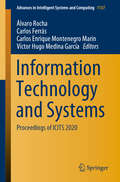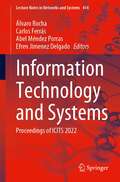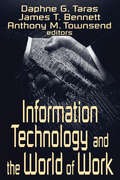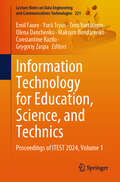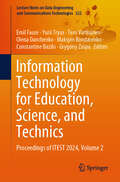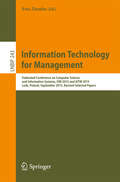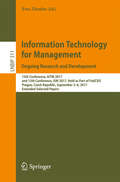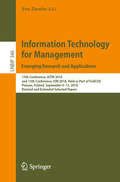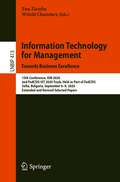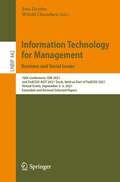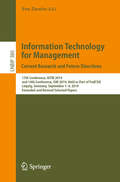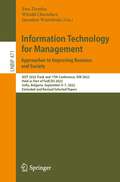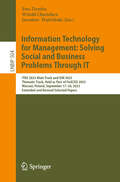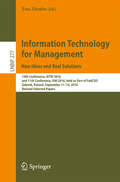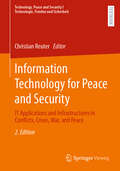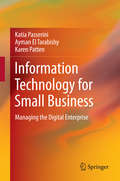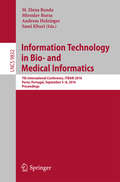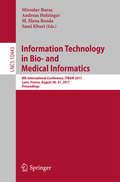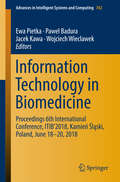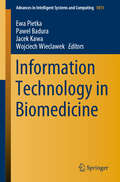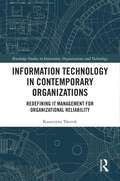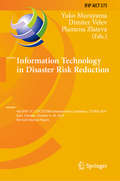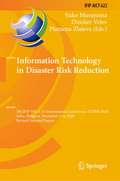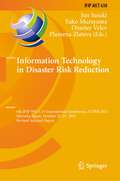- Table View
- List View
Information Technology and Systems: Proceedings of ICITS 2020 (Advances in Intelligent Systems and Computing #1137)
by Álvaro Rocha Carlos Ferrás Carlos Enrique Montenegro Marin Víctor Hugo Medina GarcíaThis book is composed by the papers accepted for presentation and discussion at The 2019 International Conference on Information Technology & Systems (ICITS'20), held at the Universidad Distrital Francisco José de Caldas, in Bogotá, Colombia, on 5th to 7th February 2020. ICIST is a global forum for researchers and practitioners to present and discuss recent findings and innovations, current trends, professional experiences and challenges of modern information technology and systems research, together with their technological development and applications. The main topics covered are: information and knowledge management; organizational models and information systems; software and systems modelling; software systems, architectures, applications and tools; multimedia systems and applications; computer networks, mobility and pervasive systems; intelligent and decision support systems; big data analytics and applications; human–computer interaction; ethics, computers & security; health informatics; information technologies in education.
Information Technology and Systems: Proceedings of ICITS 2022 (Lecture Notes in Networks and Systems #414)
by Álvaro Rocha Carlos Ferrás Abel Méndez Porras Efren Jimenez DelgadoThis book is composed by the papers written in English and accepted for presentation and discussion at The 2022 International Conference on Information Technology & Systems (ICITS'22), held at Tecnológico de Costa Rica, in San Carlos, Costa Rica, between the 9th and the 11th of February 2022.ICIST is a global forum for researchers and practitioners to present and discuss recent findings and innovations, current trends, professional experiences and challenges of modern information technology and systems research, together with their technological development and applications.The main topics covered are: information and knowledge management; organizational models and information systems; software and systems modelling; software systems, architectures, applications and tools; multimedia systems and applications; computer networks, mobility and pervasive systems; intelligent and decision support systems; big data analytics and applications; human–computer interaction; ethics, computers & security; health informatics; information technologies in education, and Media, Applied Technology and Communication.
Information Technology and the World of Work
by James T. Bennett Anthony M. Townsend Daphne Gottlieb TarasInformation technologies have become both a means and an end, transforming the workplace and how work is performed. This ongoing evolution in the work process has received extensive coverage but relatively little attention has been given to how changing technologies and work practices affect the workers themselves. This volume specifi cally examines the institutional and social environment of the workplaces that information technologies have created.
Information Technology for Education, Science, and Technics: Proceedings of ITEST 2024, Volume 1 (Lecture Notes on Data Engineering and Communications Technologies #221)
by Emil Faure Olena Danchenko Maksym Bondarenko Yurii Tryus Constantine Bazilo Grygoriy Zaspa Tero VartiainenThis book deals with issues related to multi-faceted applications of information and communication technology in research, engineering, robotics, automation of technological processes, complex systems, and computer networks, as well as mathematical and computer modelling of physical, chemical, and economic processes. In this book, the authors explore various aspects of information and communication technology and systems and their integration into science, engineering, automation, and economics. The authors develop new models, methods, and approaches for monitoring and controlling systems, communication networks, artificial intelligence applications, and digital resilience. The book is of interest to experts in the field of information and communication technology and systems, scientists, and Ph.D. students.
Information Technology for Education, Science, and Technics: Proceedings of ITEST 2024, Volume 2 (Lecture Notes on Data Engineering and Communications Technologies #222)
by Emil Faure Olena Danchenko Maksym Bondarenko Yurii Tryus Constantine Bazilo Grygoriy Zaspa Tero VartiainenThis book explores issues related to information and communication technology in management and higher education, intelligent computing, and information security. In this book, the authors investigate various aspects of information and communication technology and systems, their development and applications in education, science, and management. The authors develop new models, methods, and approaches for digital transformation in management processes including digital project management, intelligent systems, particularly those that deploy artificial intelligence, data protection, and reliability. A part of this book is devoted to the application of information and communication technology in higher education to ensure the process of digital transformation in higher education institutions. The book is of interest to experts in the field of information and communication technology and systems, project managers, scientists, and Ph.D. students.
Information Technology for Management
by Ewa ZiembaThis book constitutes revised and extended versions of the best papers from the 10th Conference on Information Systems Management (ISM 2015) and 13th Conference on Advanced Information Technologies for Management (AITM 2015), held in Lodz, Poland, September 2015 as part of the Federated Conference on Computer Science and Information Systems (FedCSIS 2015). These events constitute a forum for the exchange of ideas for practitioners and theorists working in the broad area of information systems management in organizations and to present and discuss the current issues of IT in business applications. The 11 full papers included in this volume were carefully reviewed and selected originally 54 submissions. They focus on knowledge management systems; information technology for business and public organizations; and evaluation of information systems.
Information Technology for Management. Ongoing Research and Development: 15th Conference, Aitm 2017, And 12th Conference, Ism 2017, Held As Part Of Fedcsis, Prague, Czech Republic, September 3-6, 2017, Extended Selected Papers (Lecture Notes In Business Information Processing #311)
by Ewa ZiembaThis book constitutes extended selected papers from the 15th Conference on Advanced Information Technologies for Management, AITM 2017, and the 12th Conference on Information Systems Management, ISM 2017, held as part of the Federated Conference on Computer Science and Information Systems, FedCSIS, which took place in Prague, Poland, in September 2017. The 13 papers presented in this volume were carefully reviewed and selected from 48 submissions. They were organized in topical sections named: information technology and systems for knowledge management; information technology and systems for business transformation; and implementation and evaluation of information systems.
Information Technology for Management: 15th Conference, AITM 2018, and 13th Conference, ISM 2018, Held as Part of FedCSIS, Poznan, Poland, September 9–12, 2018, Revised and Extended Selected Papers (Lecture Notes in Business Information Processing #346)
by Ewa ZiembaThis book constitutes extended selected papers from the 16th Conference on Advanced Information Technologies for Management, AITM 2018, and the 13th Conference on Information Systems Management, ISM 2018, held as part of the Federated Conference on Computer Science and Information Systems, FedCSIS, which took place in Poznan, Poland, in September 2018. The total of 9 full and 3 short papers presented in this volume were carefully reviewed and selected from a total of 43 submissions. The papers selected to be included in this book contribute to the understanding of relevant trends of current research on information technology for management in business and public organizations. They were organized in topical sections named: information technology and systems for knowledge management, and information technology and systems for business transformation.
Information Technology for Management: 15th Conference, ISM 2020, and FedCSIS-IST 2020 Track, Held as Part of FedCSIS, Sofia, Bulgaria, September 6–9, 2020, Extended and Revised Selected Papers (Lecture Notes in Business Information Processing #413)
by Ewa Ziemba Witold ChmielarzThis book constitutes revised selected and extended papers presented at track 4 of the Conference on Computer Science and Intelligence Systems, FedCSIS 2020, which took place in Sofia, Bulgaria, during September 6–9, 2020. The FedCSIS Information Systems and Technologies Track included AIST 2020, DSH 2020, ISM 2020, and KAM 2020. For this track, a total of 29 submissions was received from which a total of 5 full and 3 short papers was accepted for publication in this volume. The papers were organized in topical sections named: improving project management methods; numerical methods of solving management problems; and technological infrastructure for business excellence.
Information Technology for Management: 16th Conference, ISM 2021, and FedCSIS-AIST 2021 Track, Held as Part of FedCSIS 2021, Virtual Event, September 2–5, 2021, Extended and Revised Selected Papers (Lecture Notes in Business Information Processing #442)
by Ewa Ziemba Witold ChmielarzThis book constitutes revised selected and extended papers presented at track 4 on "Advances in Information Systems and Technologies" of the Conference on Computer Science and Intelligence Systems, FedCSIS 2021, which was held online during September 2–5, 2021. The FedCSIS Track 4 included AIST 2021, DSH 2021, ISM 2021, and KAM 2021. For this track, a total of 30 submissions was received from which a 7 full papers and 1 short papers were accepted for publication in this volume. The papers were organized in topical sections named as follows: Approaches to improving management systems; solutions to social issues; methods for supporting business and society.
Information Technology for Management: 17th Conference, AITM 2019, and 14th Conference, ISM 2019, Held as Part of FedCSIS, Leipzig, Germany, September 1–4, 2019, Extended and Revised Selected Papers (Lecture Notes in Business Information Processing #380)
by Ewa ZiembaThis book constitutes extended selected papers from the 17th Conference on Advanced Information Technologies for Management, AITM 2019, and the 14th Conference on Information Systems Management, ISM 2019, held as part of the Federated Conference on Computer Science and Information Systems, FedCSIS, which took place in Leipzig, Germany, in September 2019. The total of 7 full and 6 short papers presented in this volume were carefully reviewed and selected from a total of 45 submissions. The papers selected to be included in this book contribute to the understanding of relevant trends of current research on and future directions of information technology for management in business and public organizations. They were organized in topical sections named: information technology assessment for future development; methods and models for designing information technology, and aspects of implementing information technology.
Information Technology for Management: AIST 2022 Track and 17th Conference, ISM 2022, Held as Part of FedCSIS 2022, Sofia, Bulgaria, September 4–7, 2022, Extended and Revised Selected Papers (Lecture Notes in Business Information Processing #471)
by Ewa Ziemba Witold Chmielarz Jarosław WątróbskiThis book constitutes revised selected and extended papers presented at track 4 of the Conference on Computer Science and Intelligence Systems, FedCSIS 2022, which took place in Sofia, Bulgaria, during September 4–7, 2022.The FedCSIS Information Systems and Technologies Track included AIST 2022, ISM 2022, DSH 2022, and KAM 2022. AIST 2022 received 11 submissions, from which 2 full papers and 1 short paper have been accepted; for ISM 2022 2 full and 3 short papers have been accepted from 15 submissions; and for DSH 2022 2 full and 1 short papers have been accepted from 11 submissions. From the 17 submissions to KAM 2022, no paper passed the extended reviews, so the overall acceptance rate was 20% for full and 18% for short papers. The papers were organized in topical sections named: Approaches to improving business; approaches to improving society; and methods for improving business and society.
Information Technology for Management: ITBS 2023 Main Track and ISM 2023 Thematic Track, Held as Part of FedCSIS 2023, Warsaw, Poland, September 17–20, 2023, Extended and Revised Selected Papers (Lecture Notes in Business Information Processing #504)
by Ewa Ziemba Witold Chmielarz Jarosław WątróbskiThe present book includes extended and revised versions of a set of selected papers submitted to the Topical Area of Information Technology for Business and Society, ITBS 2023, and two Thematic Tracks: Information System Management, ISM 2023, and Knowledge Acquisition and Management, KAM 2023, held in Poland, Warsaw, during September 17- 20, 2023. ITBS 2023 received 26 submissions, from which 6 full papers and 2 short papers have been accepted; for ISM 2023 3 full papers and 1 short paper have been accepted from 21 submissions; and for KAM 2023 1 full paper has been accepted from 7 submissions. From the 6 submissions to DSH 2023, no paper passed the extended reviews. The accepted papers are grouped in sections on IT in Improving of Management Systems, Approaches to Improving of Social Problems, and Methods of Solving Business.
Information Technology for Management: New Ideas and Real Solutions
by Ewa ZiembaThis book constitutes revised selected papers from the 14th Conference on Advanced Information Technologies for Management, AITM 2016, and the 11th Conference on Information Systems Management, ISM 2016, held as part of the Federated Conference on Computer Science and Information Systems, FedCSIS, which took place in Gdansk, Poland, in September 2016. The 13 papers presented in this volume were carefully reviewed and selected from 51 submissions. They were organized in topical sections named: information technology and systems for knowledge management; information technology and systems for business transformation; and implementation and evaluation of information systems.
Information Technology for Manufacturing: Reducing Costs and Expanding Capabilities
by Kevin Ake John Clemons Mark Cubine Bruce LillyThe rate of change in manufacturing today is faster than ever. Retailers and consumers demand flexibility and responsiveness, regulatory oversight is on the rise, and increasing consolidations require companies to demonstrate cost and efficiency improvements. Information Technology for Manufacturing describes how IT can help manufacturers e
Information Technology for Peace and Security: IT Applications and Infrastructures in Conflicts, Crises, War, and Peace (Technology, Peace and Security I Technologie, Frieden und Sicherheit)
by Christian ReuterTechnological and scientific progress, especially the rapid development in information technology (IT) and artificial intelligence (AI), plays a crucial role regarding questions of peace and security. This textbook, extended and updated in its second edition, addresses the significance, potential of IT, as well as the challenges it poses, with regard to peace and security. It introduces the reader to the concepts of peace, conflict, and security research, especially focusing on natural, technical and computer science perspectives. In the following sections, it sheds light on cyber conflicts, war and peace, cyber arms control, cyber attribution, infrastructures, artificial intelligence, as well ICT in peace and conflict.
Information Technology for Small Business
by Ayman El Tarabishy Karen Patten Katia PasseriniInformation Technology for Small Business: Managing the Digital Enterprise provides an overview of how small and medium business enterprises (SMEs) can use flexibility, agility, and anticipation strategies to better utilize information technology and knowledge management. Because small and medium businesses tend to be late technology adopters, they could miss versatile and strategic workforce advantages that enable them to achieve higher efficiency and effectiveness through technology. This book shows these SMEs new technology trends that can transform the nature of their operations both in an evolutionary business path and through revolutionary opportunities. Information Technology for Small Business: Managing the Digital Enterprise applied correctly to small and medium business can be used as a strategic tool to reach growth and profit goals for the SMEs competing in a very dynamic and global marketplace. Examples include: identifying ways that IT can be used to develop strong relationships with customers and suppliers, and how to select the best technologies for business needs. Information Technology for Small Business: Managing the Digital Enterprise targets SME owners, educators, and practitioners working in the related fields of management, IT, IS, and CS-related disciplines. Advanced-level students and policy makers focusing on SMEs will also find this book valuable in terms of main concepts for discussion.
Information Technology in Bio- and Medical Informatics
by M. Elena Renda Miroslav Bursa Andreas Holzinger Sami KhuriThis book constitutes the refereed proceedings of the 6th International Conference on Information Technology in Bio- and Medical Informatics, ITBAM 2015, held in Valencia, Spain, in September 2015, in conjunction with DEXA 2015. The 9 revised long papers presented together with 1 poster paper were carefully reviewed and selected from 15 submissions. The papers address the following two topics: medical terminology and clinical processes and machine learning in biomedicine.
Information Technology in Bio- and Medical Informatics: 8th International Conference, ITBAM 2017, Lyon, France, August 28–31, 2017, Proceedings (Lecture Notes in Computer Science #10443)
by Miroslav Bursa, Andreas Holzinger, M. Elena Renda and Sami KhuriThis book constitutes the refereed proceedings of the 8th International Conference on Information Technology in Bio- and Medical Informatics, ITBAM 2017, held in Lyon, France, in August 2017.The 3 revised full papers and 6 poster papers presented were carefully reviewed and selected from 15 submissions. The papers address a broad range of topics in applications of information technology to biomedical engineering and medical informatics.
Information Technology in Biomedicine: Proceedings 6th International Conference, ITIB’2018, Kamień Śląski, Poland, June 18–20, 2018 (Advances in Intelligent Systems and Computing #762)
by Pawel Badura Jacek Kawa Wojciech Wieclawek Ewa PietkaITiB’2018 is the 6th Conference on Information Technology in Biomedicine, hosted every two years by the Department of Informatics & Medical Devices, Faculty of Biomedical Engineering, Silesian University of Technology. The Conference is organized under the auspices of the Committee on Biocybernetics and Biomedical Engineering of the Polish Academy of Sciences. The meeting has become an established event that helps to address the demand for fast and reliable technologies capable of processing data and delivering results in a user-friendly, timely and mobile manner. Many of these areas are recognized as research and development frontiers in employing new technology in the clinical setting. Technological assistance can be found in prevention, diagnosis, treatment, and rehabilitation alike. Homecare support for any type of disability may improve standard of living and make people’s lives safer and more comfortable. The book includes the following sections: Ø Image Processing Ø Multimodal Imaging and Computer-aided Surgery Ø Computer-aided Diagnosis Ø Signal Processing and Medical Devices Ø Bioinformatics Ø Modelling & Simulation Ø Analytics in Action on the SAS Platform Ø Assistive Technologies and Affective Computing (ATAC)
Information Technology in Biomedicine: Proceedings 6th International Conference, Itib'2018 Kamieski, Poland June 18-20 2018 (Advances in Intelligent Systems and Computing #1011)
by Pawel Badura Jacek Kawa Wojciech Wieclawek Ewa PietkaThis book provides a comprehensive overview of advances in the field of medical data science, presenting carefully selected articles by leading information technology experts. Information technology, as a rapidly evolving discipline in medical data science, with significant potential in future healthcare, and multimodal acquisition systems, mobile devices, sensors, and AI-powered applications has redefined the optimization of clinical processes. This book features an interdisciplinary collection of papers that have both theoretical and applied dimensions, and includes the following sections: Medical Data Science Quantitative Data Analysis in Medical Diagnosis Data Mining Tools and Methods in Medical Applications Image Analysis Analytics in Action on SAS Platform Biocybernetics in Physiotherapy Signal Processing and Analysis Medical Tools & Interfaces Biomechanics and Biomaterials. As such, it is a valuable reference tool for scientists designing and implementing information processing tools used in systems that assist clinicians in patient care. It is also useful for students interested in innovations in quantitative medical data analysis, data mining, and artificial intelligence.
Information Technology in Contemporary Organizations: Redefining IT Management for Organizational Reliability (Routledge Studies in Innovation, Organizations and Technology)
by Katarzyna TworekDue to tremendous shifts in the business environment of contemporary organizations following the COVID-19 pandemic, there is a need to redefine the role and importance of information technology (IT) support, which is essential for ensuring an organization’s survival. Current models are no longer valid, as in the new turbulent and digitalized environment, the need for IT support is more crucial and indispensable than ever. This book proposes a new model explaining the factors inf luencing the efficiency of adaptable IT support in contemporary organizations, including those operating normally and during crises. The author demonstrates how organizations benefit from IT support, not only by enabling higher performance but also by facilitating organizational continuity, reliability, and even survival during various stages of crisis. The proposed model provides a basis for theory development in the field of organizational continuity and reliability, offering a new body of knowledge related to the factors boosting organizational performance gained from IT support and enabling organizational survival. This book will provide valuable findings for scholars performing research in the field of IT use in organizations, IT management, crisis management, and organizational reliability.
Information Technology in Disaster Risk Reduction: 4th IFIP TC 5 DCITDRR International Conference, ITDRR 2019, Kyiv, Ukraine, October 9–10, 2019, Revised Selected Papers (IFIP Advances in Information and Communication Technology #575)
by Yuko Murayama Dimiter Velev Plamena ZlatevaThis volume constitutes the refereed and revised post-conference proceedings of the 4th IFIP TC 5 DCITDRR International Conference on Information Technology in Disaster Risk Reduction, ITDRR 2019, in Kyiv, Ukraine, in October 2019. The 17 full papers and 2 short papers presented were carefully reviewed and selected from 53 submissions. The papers focus on various aspects and challenges of coping with disaster risk reduction. The main topics include areas such as natural disasters, big data, cloud computing, Internet of Things, mobile computing, emergency management, disaster information processing, and disaster risk assessment and management.
Information Technology in Disaster Risk Reduction: 5th IFIP WG 5.15 International Conference, ITDRR 2020, Sofia, Bulgaria, December 3–4, 2020, Revised Selected Papers (IFIP Advances in Information and Communication Technology #622)
by Yuko Murayama Dimiter Velev Plamena ZlatevaThis volume constitutes the refereed and revised post-conference proceedings of the 5th IFIP WG 5.15 International Conference on Information Technology in Disaster Risk Reduction, ITDRR 2020, in Sofia, Bulgaria, in December 2020.* The 18 full papers and 6 short papers presented were carefully reviewed and selected from 52 submissions. The papers focus on various aspects and challenges of coping with disaster risk reduction. The main topics include areas such as natural disasters, remote sensing, big data, cloud computing, Internet of Things, mobile computing, emergency management, disaster information processing, disaster risk assessment and management. *The conference was held virtually.
Information Technology in Disaster Risk Reduction: 6th IFIP WG 5.15 International Conference, ITDRR 2021, Morioka, Japan, October 25–27, 2021, Revised Selected Papers (IFIP Advances in Information and Communication Technology #638)
by Yuko Murayama Jun Sasaki Dimiter Velev Plamena ZlatevaThis volume constitutes the refereed and revised post-conference proceedings of the 6th IFIP WG 5.15 International Conference on Information Technology in Disaster Risk Reduction, ITDRR 2021, in Morioka, Japan, in October 2021. The 11 full papers presented were carefully reviewed and selected from 18 submissions. The papers focus on various aspects and challenges of coping with disaster risk reduction. The papers are categorized in the following topical subheadings: Information Analysis for Situation Awareness; Evacuation and Rescue; COVID-19 Issues; and IT Use for Risk and Disaster Management.
